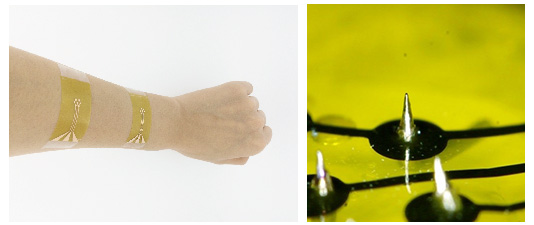By Noboru Kuno (opens in new tab), Research Program Manager, Microsoft Research
Researchers at Microsoft and Tokyo’s Keio University have developed systems that could allow people to use tiny, painless needles to do things like monitor medical conditions or receive information without looking at a screen.
The research project, which explores the convergence of micro- and nanotechnology, wearable sensors and actuators for human computer interaction, was among the winning innovations on display at “Japan Korea Academic Day,” held recently in Tokyo.
Microsoft Research Podcast
Ideas: Language technologies for everyone with Kalika Bali
The new series “Ideas” debuts with guest Kalika Bali. The speech and language tech researcher talks sci-fi and its impact on her career, the design thinking philosophy behind her research, and the “outrageous idea” she had to work with low-resource languages.
The project, “Wearable Human Interface Devices Using Micro-Needles,” could spearhead new forms of medical self-monitoring and novel ways of receiving information without the need to look at a screen, a potential boon for distraction-free driving, immersive gaming and other activities.
Led by Norihisa Miki, associate professor at Keio University, the project was one of seven winners recognized for best exemplifying the unique and fascinating research results emerging from collaboration between Microsoft Research Asia and academic institutions. In particular, Miki’s project was lauded as a “great symbol of what Microsoft aims to inspire through collaboration with leading researchers and scientists in the Asia-Pacific region.”
A key finding for Miki came in 2015 when his team at Keio University’s Miki Laboratory (opens in new tab) discovered that the outermost layer of the skin (stratum corneum) could also serve as an effective interface. Soon after, Miki and his colleagues started developing “micro-needle-based human interface devices” with support from Microsoft Research.
These devices have great promise for a number of reasons.
For one, they’re unobtrusive: Limiting the needle length to the depth of the stratum corneum, a layer of 15-20 dead cells, the needles don’t go deep enough to cause any pain.
For another, they’re very energy-efficient: The needle-type electro-tactile displays transfer tactile information at a much lower voltage than conventional flat electro-tactile types.
Further, they’re highly accurate and adaptable: The needle-type electrodes for EEG can conduct high-quality measurements. This shape also was optimized for electrode density, mechanical strength and to ensure the needles wouldn’t reach pain points.

Norihisa Miki, associate professor Keio University
With the popularity of wearable devices soaring, it’s becoming more vital to acquire data with high sensitivity and accuracy, and also to transfer information back to users with accuracy and low power consumption.

Candle-like EEG electrodes
The team has also created flexible and wearable needle-type electro-tactile displays. These can be attached to the body and efficiently transfer information to users through tactile sensation. A device attached to the wrist could send tactile information and feedback to users, providing new ways for patients to capture critical medical information in the home such as measuring the effectiveness of medications.

The micro-needle devices are currently designed to be worn comfortably only for short periods. Research is now underway into form factors for longer term use, exploring other types of material along with different shapes and densities.
Although Miki’s team acknowledges that some users may be apprehensive about the notion of wearing anything with needles, they’re confident that user adoption won’t be hindered given the device’s actual comfort and valuable uses.



